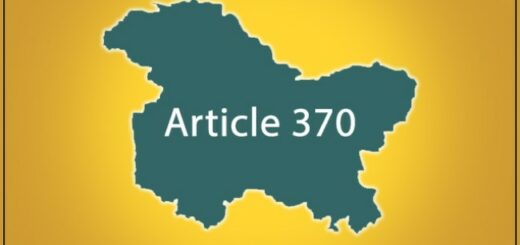National Current Affairs – UPSC/IAS Exams- 21st November 2019
Mizoram revoked FRA
Topic: Polity and Governance
In News: Stoppage of funds by the Union government since 2014-15 for the implementation of the Scheduled Tribes and Other Traditional Forest Dwellers (Recognition of Forest Rights) Act, 2006 (FRA) and low levels of claims made the Mizoram government revoke the FRA law.
More on the Topic:
- Under Article 371 (G) of the Constitution, Mizoram has a special provision which makes it mandatory for all legislations of Parliament pertaining to land ownership and transfer to be first passed by the state’s assembly through a resolution before it can be implemented in the state.
- Mizoram had passed a resolution implementing the Act in 2009 and the Act has been applicable in the state since December 21, 2009.
- The state’s assembly passed a resolution on November 19, revoking the implementation of the Act in the state.
Concerns:
- According to the 2017 State of Forest Report by the Forest Survey of India, around 20% of the total 5,641 square kilometres of the forest land in Mizoram is “Unclassed Forest” which is under Autonomous District Councils.
- The area of unclassed forest is lowest in Mizoram, among all North Eastern states. This also means that the potential for FRA implementation is also the highest in the state.
- With a major portion of the geographical area of states like Mizoram under forest cover, and communities having ownership on those lands, revoking FRA can be seen as a means to keep the forest land with the forest departments for later diversion.
About FRA:
- The Scheduled Tribes and Other Traditional Forest Dwellers (Recognition of Forest Rights) Act, 2006, was enacted to protect the marginalised socio-economic class of citizens and balance the right to environment with their right to life and livelihood.
- Eligibility to get rights under the Act is confined to those who “primarily reside in forests” and who depend on forests and forest land for a livelihood.
- Further, either the claimant must be a member of the Scheduled Tribes scheduled in that area or must have been residing in the forest for 75 years.
Rights under the Act:
- Ownership to land that is being farmed by tribals or forest dwellers subject to a maximum of 4 hectares; ownership is only for land that is actually being cultivated by the concerned family, meaning that no new lands are granted.
- The dwellers will have rights to minor forest produce (also including ownership), to grazing areas, to pastoralist routes, etc.
- Relief and development rights available under the act include rights to rehabilitation in case of illegal eviction or forced displacement; and to basic amenities, subject to restrictions for forest protection.
- They will have the rights to protect forests and wildlife as well.
Source: Down To Earth
Pradhan Mantri Kisan Maan-Dhan Yojana (PM-KMY)
Topic: Government Schemes
In News: Union Minister Narendra Singh Tomar on informed the Lok Sabha that over 18 lakh farmers have registered themselves under the Pradhan Mantri Kisan Maan-Dhan Yojana (PM-KMY). The Scheme aims to cover around 3 crore beneficiaries.
More on the Topic:
- PMKMY is a Central Sector Scheme to provide social security net for the Small and Marginal Farmers (SMF) as they have minimal or no savings to provide for old age and to support them in the event of the consequent loss of livelihood.
- Under this Scheme, a minimum fixed pension of Rs 3,000 is provided to the eligible small and marginal farmers, subject to certain exclusion clauses, on attaining the age of 60 years. It is a voluntary and contributory pension scheme, with an entry age of 18 to 40 years.
- The beneficiary can opt to become a member of the Scheme by subscribing to a Pension Fund managed by the Life Insurance Corporation of India (LIC).
- The beneficiary is required to make a monthly contribution of between Rs.55/- to Rs.200/- to the Pension Fund, depending on the age of entry into the Scheme, with the provision of equal contribution by the Central Government.
- Exit from the scheme may be voluntarily or on the failure of contribution or on demise.
Source: The Hindu
Prithvi 2 Missile
Topic: Science and Technology
In News: India successfully test fired its indigenously developed nuclear capable Prithvi-2 missile as part of a user trial by the Army from a test range off Odisha coast.
More on the Topic:
- It is a tactical surface-to-surface short-range ballistic missile (SRBM) developed by DRDO of India under the Integrated Guided Missile Development Program (IGMDP). It is deployed by India’s Strategic Forces Command.
- The state-of-the-art missile is powered by liquid propulsion twin engines. It uses an advanced inertial guidance system with maneuvering orbit to hit its target. It was inducted into armour of the defence forces in 2003.
- The Government of India launched the Integrated Guided Missile Development Program in 1983 to achieve self-sufficiency in the development and production of wide range of ballistic missiles, surface-to-air missiles etc. Prithvi was the first missile to be developed under the program.
Source: Hindustan Times
Note:
This material has been prepared for nammakpsc students. NammaKpSc academy is number 1 academy for KPSC, KAS exams located in Bangalore in Hebbal and vijayanagara. Visit www.nammakpsc.com for more details and materials.
Swachh Survekshan Grameen Awards 2019
Topic: Governance
In News: The Government of India conferred the Swachh Survekshan Grameen 2019 awards to top ranked states, union territories, and districts in the various categories.
More on the Topic:
- The Department of Drinking Water and Sanitation (DDWS) had commissioned “Swachh Survekshan Grameen-2019” (SSG 2019) through an independent survey agency to develop ranking of all districts of India on the basis of quantitative and qualitative sanitation (Swachhata) parameters.
- This ranking was done based on a comprehensive set of parameters including surveys of public places like schools, Anganwadis, PHCs, Haat/ Bazaars, Panchayat and citizen’s perception of Swachhata and their recommendations for improvement of the program and data from the SBM-G IMIS.
Immediate Out Come of the Ranking:
- The SSG 2019 turned out to be massive mass mobilisation exercise with communities in each village undertaking special drives to improve the general cleanliness in their villages.
- Gram Panchayats invested funds from their local area development fund to augment the sanitation situation in public places.
The top ranked States and Districts:
- Top 3 States: 1) Tamil Nadu, 2) Haryana, 3) Gujarat
- Top 3 Districts: 1) Peddapalli, Telangana, 2) Faridabad, Haryana, 3) Rewari, Haryana
- State with maximum citizen participation: 1) Uttar Pradesh
Source: PIB
Sowa Rigpa
Topic: Culture
In News: The Union Cabinet yesterday approved the establishment of the National Institute for Sowa-Rigpa (NISR) in Leh as an autonomous organization under the Ministry of AYUSH at an estimated cost of Rs. 47.25 crore.
More on the Topic:
- The setting up of the National Institute of Sowa-Rigpa (NISR) would provide an impetus for the revival of Sowa-Rigpa in the Indian Sub-continent. The Institute will also provide opportunities for students of Sowa-Rigpa not only in India but also from other countries.
About Sowa Rigpa:
- “Sowa-Rigpa” commonly known as Tibetan system of medicine is one of the oldest, Living and well documented medical tradition of the world.
- It has been originated from Tibet and popularly practice in India, Nepal, Bhutan, Mongolia and Russia. The majority of theory and practice of Sowa-Rigpa is similar to “Ayurveda”.
- Yuthog Yonten Gonpo from Tibet is believed to be the father of Sowa Rigpa.
- In India, it is widely practised in Sikkim, Arunachal Pradesh, West Bengal’s Darjeeling, Himachal Pradesh and the Union Territory of Ladakh.
Source: PIB
UDAN 4.0
Topic: Government Policies
In News: The Minister of State for Civil Aviation has announced that UDAN 4.0 will be launched. UDAN 4.0 seeks to offer priority routes connecting Bilaspur and Ambikapur airports in Chhattisgarh.
More on the Topic:
- Ude Desh Ka Aam Naagrik (UDAN) was launched as a regional connectivity scheme under the Ministry of Civil Aviation in 2016.
- It is an innovative scheme to develop the regional aviation market.
- The objective of scheme is to create affordable yet economically viable and profitable flights on regional routes so that flying becomes affordable to the common man even in small towns.
- The scheme envisages providing connectivity to un-served and underserved airports of the country through the revival of existing air-strips and airports. The scheme is operational for a period of 10 years.
- Under-served airports are those which do not have more than one flight a day, while unserved airports are those where there are no operations.
- A provision of Viability Gap Funding was included in the scheme. (Government compensating the losses while serving the non economic routes at fir prices.)
- UDAN 1.0: Under this phase, 5 airlines companies were awarded 128 flight routes to 70 airports (including 36 newly made operational airports)
- UDAN 2.0: In 2018, the Ministry of Civil Aviation announced 73 underserved and unserved airports. For the first time, helipads were also connected under phase 2 of UDAN scheme.
- Key Features of UDAN 3 included:
- Inclusion of Tourism Routes under UDAN 3 in coordination with the Ministry of Tourism.
- Inclusion of Seaplanes for connecting Water Aerodromes.
- Bringing in a number of routes in the North-East Region under the ambit of UDAN.
Read More at: http://nammakpsc.com/wp/national-current-affairs-upsckas-exams-15th-january-2019/
Source: PIB














